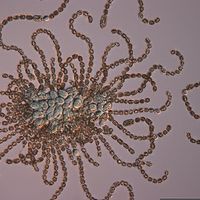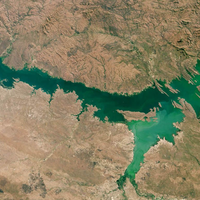Login
Subscribealgal blooms

Oxygen Levels Dropping in US and European Lakes: Study
Lisa Winter | Jun 7, 2021 | 2 min read
Researchers find a widespread decline in dissolved oxygen levels in lakes, which is known to reshape ecosystems.

Mass Elephant Die-Off Caused by Cyanobacteria, Officials Say
Max Kozlov | Sep 23, 2020 | 2 min read
Tests point to a toxic algal bloom that might have led to the unprecedented deaths of hundreds of African elephants in Botswana earlier this year, but the evidence isn’t conclusive.

Blue-Green Algae Produce Methane
Ruth Williams | Jan 15, 2020 | 3 min read
Biological production of this greenhouse gas, once thought to be the reserve of anaerobic microbes, occurs in these widespread, photosynthesizing cyanobacteria.

Red Tides Under the Microscope
Bob Grant | Nov 1, 2019 | 10+ min read
Understanding the dinoflagellates that regularly wreak havoc on marine and nearshore ecosystems in the Gulf of Mexico could help researchers mitigate the damage they cause.

Infographic: Red Tides Still Hold Tantalizing Mysteries
Bob Grant | Nov 1, 2019 | 1 min read
A full description of the lifecycle of Karenia brevis could lead to improved monitoring, prediction, and mitigation of the harmful algal blooms it regularly causes.

Image of the Day: Algal Blooms
Emily Makowski | Oct 23, 2019 | 2 min read
The majority of lakes studied experienced increased bloom intensity over the past few decades.

Thousands of Australian Animals Die in Unprecedented Heatwave
Jef Akst | Jan 17, 2019 | 2 min read
Freshwater fish suffer from low levels of oxygen in the country’s rivers, while bats are unable to survive the extreme air temperatures.

CDC to Track Algal Blooms
Bob Grant | Jun 23, 2016 | 1 min read
The federal agency launches a new system to collect nationwide data on outbreaks of harmful algae and associated health problems.

Algal Toxin Hurts Sea Lion Memory
Kerry Grens | Dec 16, 2015 | 1 min read
Results could explain why the marine mammals have been stranding on the West coast in record numbers.

Complexities of Carbon Lowering
Joe Turner | Dec 2, 2014 | 3 min read
Iron fertilization might be less efficient at storing carbon in the deep ocean than previously reported.

Viral Demise of an Algal Bloom
Jyoti Madhusoodanan | Aug 21, 2014 | 3 min read
Marine viruses may be key players in the death of massive algal blooms that emerge in the ocean, a study shows.

Toledo Water Back On After Toxic Scare
Bob Grant | Aug 5, 2014 | 1 min read
Citizens of Ohio’s fourth-largest city can drink from the tap again, but the root causes of the Lake Erie algal blooms that shut off the flow for two days remain.

Rock Snot Explained
Bob Grant | May 8, 2014 | 2 min read
An increasingly common algal growth, found in rivers the world over, is caused by changing environmental conditions, not accidental introductions.

Patchy Plankton
Chris Palmer | Dec 1, 2013 | 3 min read
Turbulence interacts with the stabilizing efforts of motile phytoplankton to create small-scale patches of toxic, bloom-forming organisms.

Science on Ice
Cristina Luiggi | Jan 2, 2013 | 1 min read
Meet the research team that uncovered an algal bloom churning in freezing Arctic waters.
Lowering Carbon with Algae
Hayley Dunning | Jul 18, 2012 | 3 min read
Spawning algal blooms by fertilizing the Southern Ocean with iron could help sink atmospheric carbon to the deep ocean—and maybe slow the course of climate change.
A Greener Arctic
Edyta Zielinska | Jun 11, 2012 | 1 min read
Algal blooms are appearing under the ice in the Arctic Ocean in areas thought to receive too little light to support photosynthetic life.
